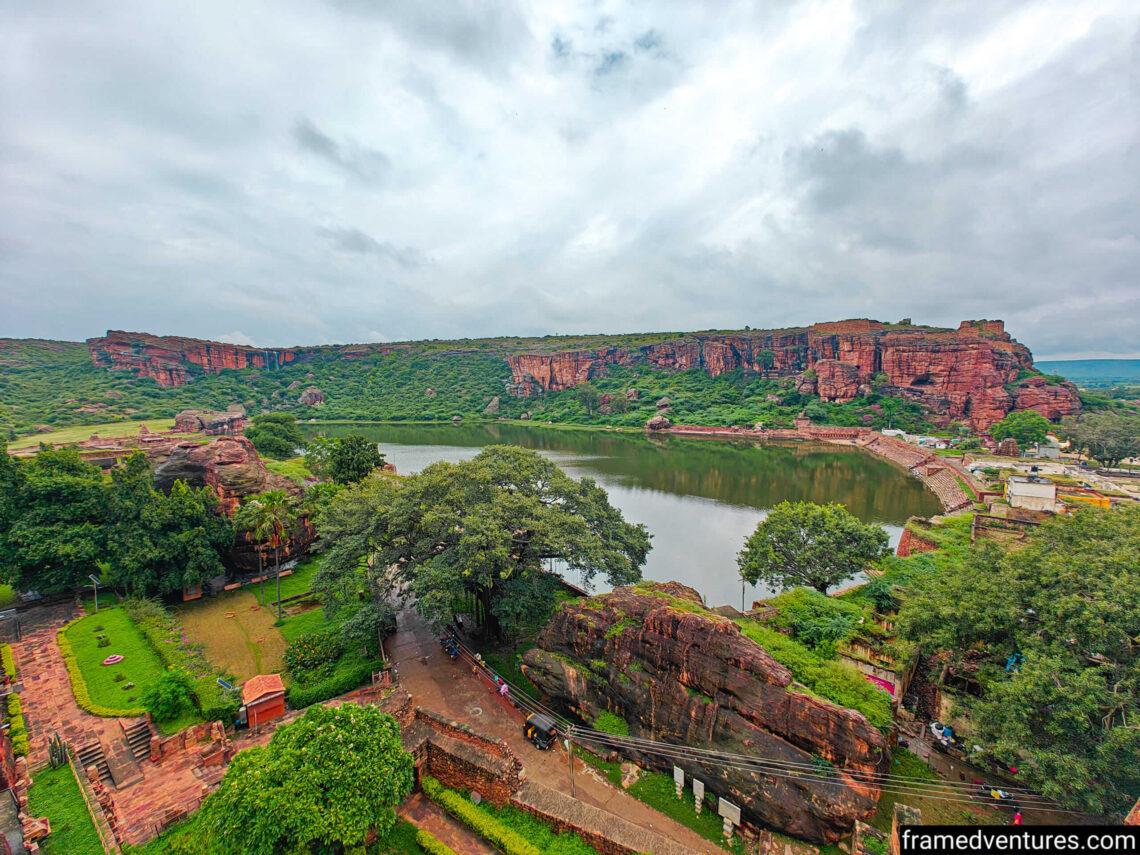
15 Places to Visit in Badami-Aihole-Pattadakal (+7 Tips)
My visit to Badami was an accident.
I was planning a trip to Hampi.
While searching for recommendations on Google, I saw a pattern.
I received suggestions for Badami while reading blogs about Hampi.
Out of curiosity, I navigated to Google Images and typed Badami.
(As a traveller, I love visualizing my destination before I plan anything.)
Half an hour later, I was intrigued. I was sold. I knew I had to visit Badami one day.
And so I did.
Long story short, it exceeded my expectations.
Badami, like Hampi, is a historical temple town in north Karnataka.
It is famous for its rock-cut temples and monuments.
In short, if you loved Hampi, you have to give Badami a visit. Or if you’re someone who loves history and architecture (like me), you can start with Badami.
Either way, it won’t take more than 2 days to visit Badami.
But Badami isn’t the only place you’ll be covering in those 2 days. You’ll also visit Aihole and Pattadikal, ancient historical sites like Badami.
With that said, let me share my solo experience with Badami-Aihole-Pattadakal so you can plan a fulfilling weekend trip.
The Fascinating History of Badami-Aihole-Pattadakal
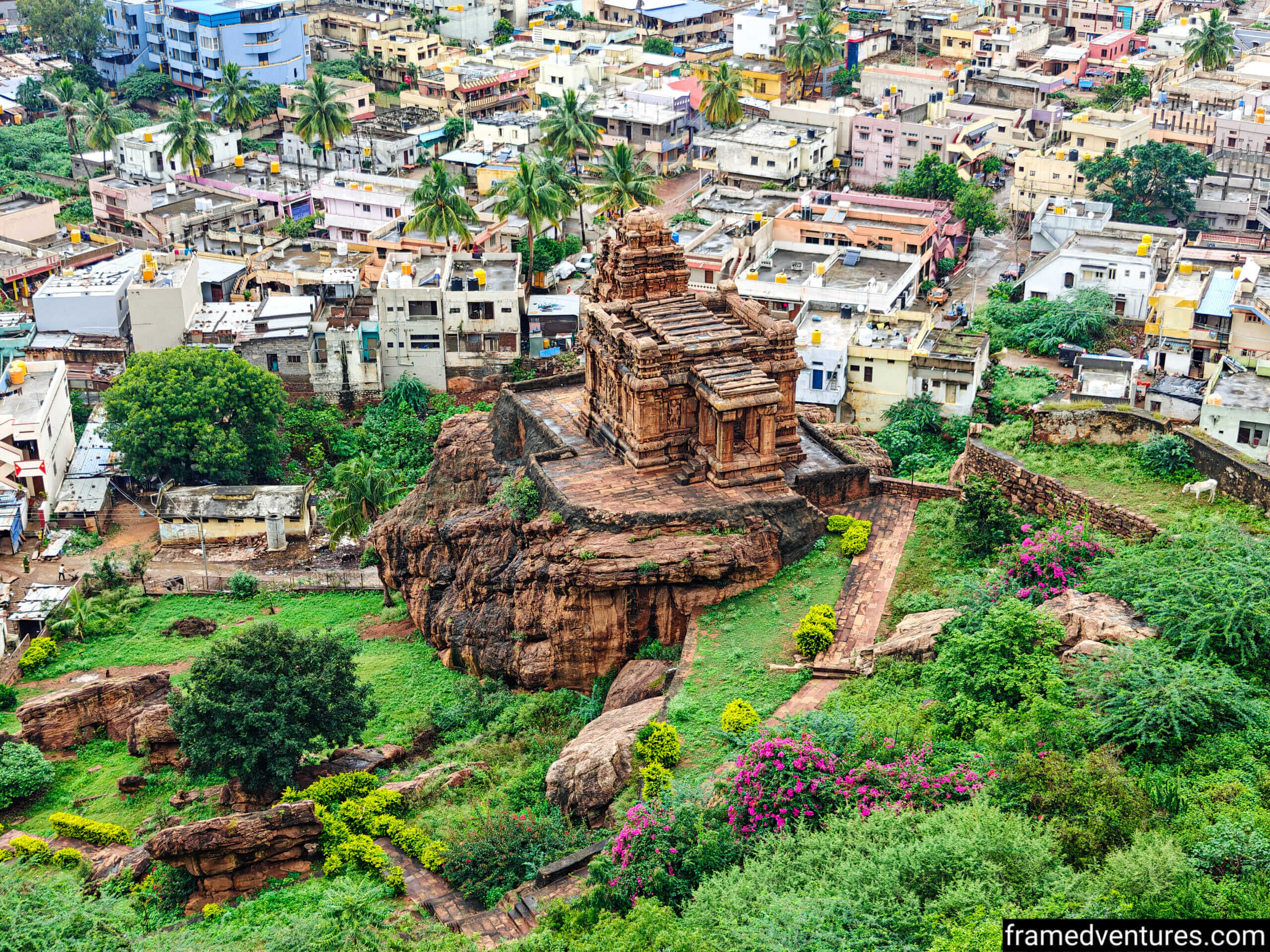
Before I get into the details, I need to give you historical context, without which nothing will make sense. Please bear with me because it will be worth it.
The Chalukya dynasty ruled southern and central India between the 6th and 12th centuries, with the Badami Chalukyas being the earliest of the lot.
During this time, they experimented with many Hindu, Buddhist, and Jain temples in Badami, Pattadakal, and Aihole.
Around the 14th century, the Delhi Sultanate raided these monuments, after which different kingdoms ruled at various times.
What you see today in Badami-Aihole-Pattadakal are the remains from those eras.
I had to mention this because the attention to detail you’ll witness in all the temple architecture will blow your mind. It is significant considering these creations were made at a time when there was no technology.
And, most of them have stood the test of time.
Where is Badami-Aihole-Pattadikal?
All three places fall in North Karnataka.
To keep it simple, let’s consider Badami as the starting point.
Badami is in the Bagalkot district of Karnataka. Pattadakal is an hour away by road, and Aihole is barely 20 minutes from Pattadakal.
If you’re travelling from Bangalore (like I did), Badami takes 10 hours, i.e., an overnight journey. And if you plan to cover Hampi as well on the same trip, that is another 3 hours from Badami.
A Simple 2-Day Itinerary For Badami-Aihole-Pattadakal
You should start your trip at Badami because it is the only town where you’ll get food, transport, and accommodation. Meanwhile, Pattadakal and Aihole are rural areas.
Now, there are 2 ways you can go about covering these places.
One is to visit Badami and Pattadakal on Day 1 and Aihole on Day 2. Or Aihole on Day 1 and Badami and Pattadakal on Day 2.
You won’t go wrong either way.
I went ahead with the second option because when I reached my homestay on Day 1, I met a family there who planned to visit Aihole that day on an auto. Since I was solo, my homestay owner told me to join them and visit Aihole for the day.
So my trip began there.
The itinerary below follows my journey henceforth in chronological order:
Day 1: Aihole
Surrounded by farms and hills, Aihole consists of 120 cave temples made of stone. However, only a handful of these temples are open to the public.
While most of these are Hindu temples, you will find some Jain ones as well.
All of these attractions are within walking distance of each other. So you won’t have to worry about transport once you reach Aihole.
1. Durga Temple: Aihole’s Top Attraction
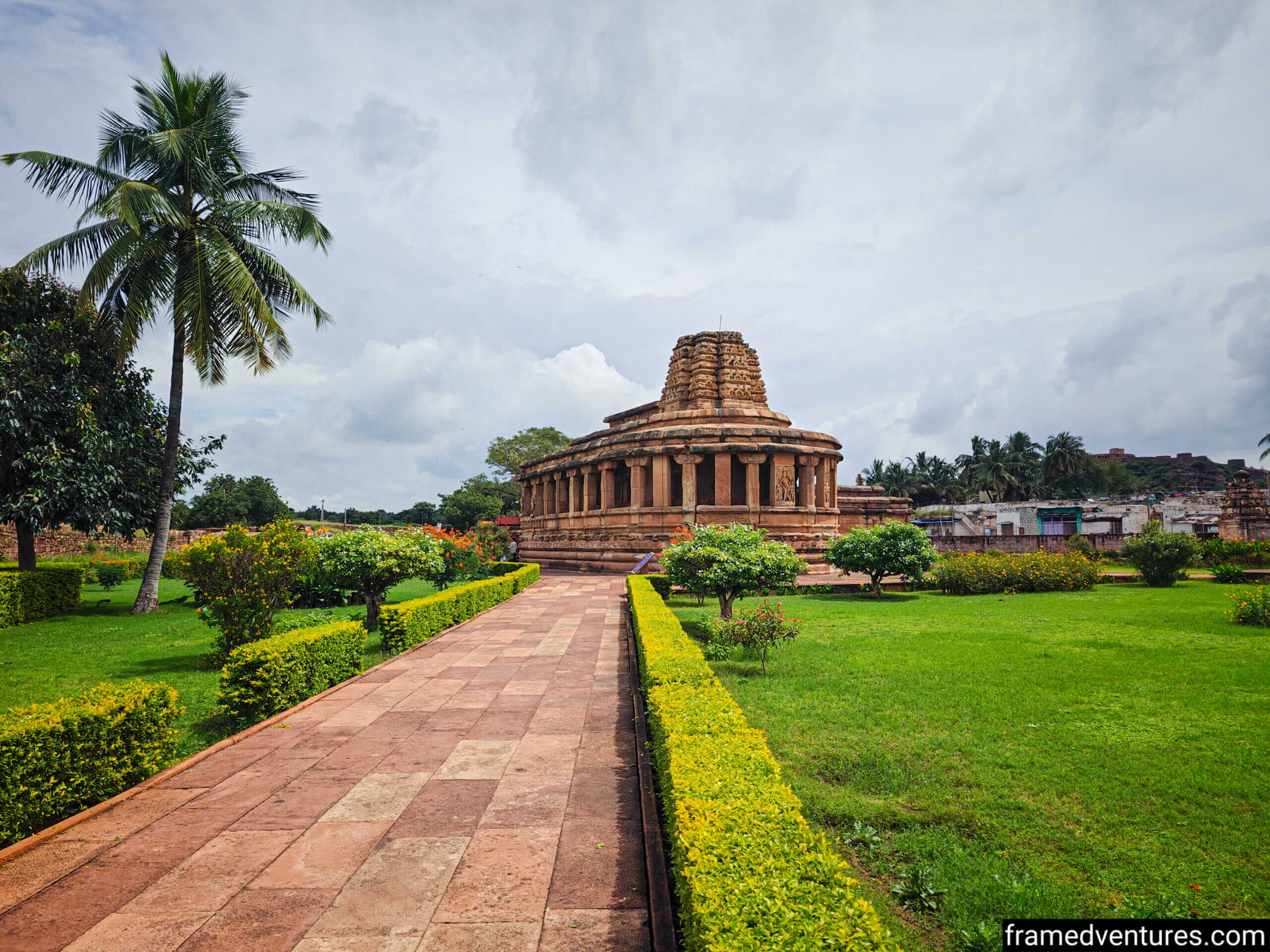
The biggest appeal of Aihole is the Durga Temple, sitting inside a vast complex of temples.
Despite being a Hindu temple, the Durga temple stands out because of its unique U-shaped structure, inspired by Buddhism. It has intricate carvings on its walls and pillars that depict various deities from Hindu mythology.
As a photographer, I loved capturing this temple from various angles, surrounded by the greenery of the temple complex amidst the backdrop of blue skies.
It’s open from 6 am to 5 pm.
You only have to buy one ticket to visit all the temples inside this complex, including the Durga Temple.
2. Aihole Museum: A Deep Dive Into History
I visited this museum after the Durga Temple, as it’s right next to it.
Here you’ll find a collection of sculptures and artefacts from Badami, Pattadakal, and Aihole. This includes many idols of the Gods and old photos of these places.
You’ll also get an idea of the history of these three regions in terms of the rulers who ruled at different periods, and how ASI reconstructed these monuments and preserved them.
Photography is not allowed.
You need to buy a separate ticket for the museum from the same counter where you got the ticket for the temples.
3. Chalukya Shiva Temple: A Hindu Temple With A Muslim Connection
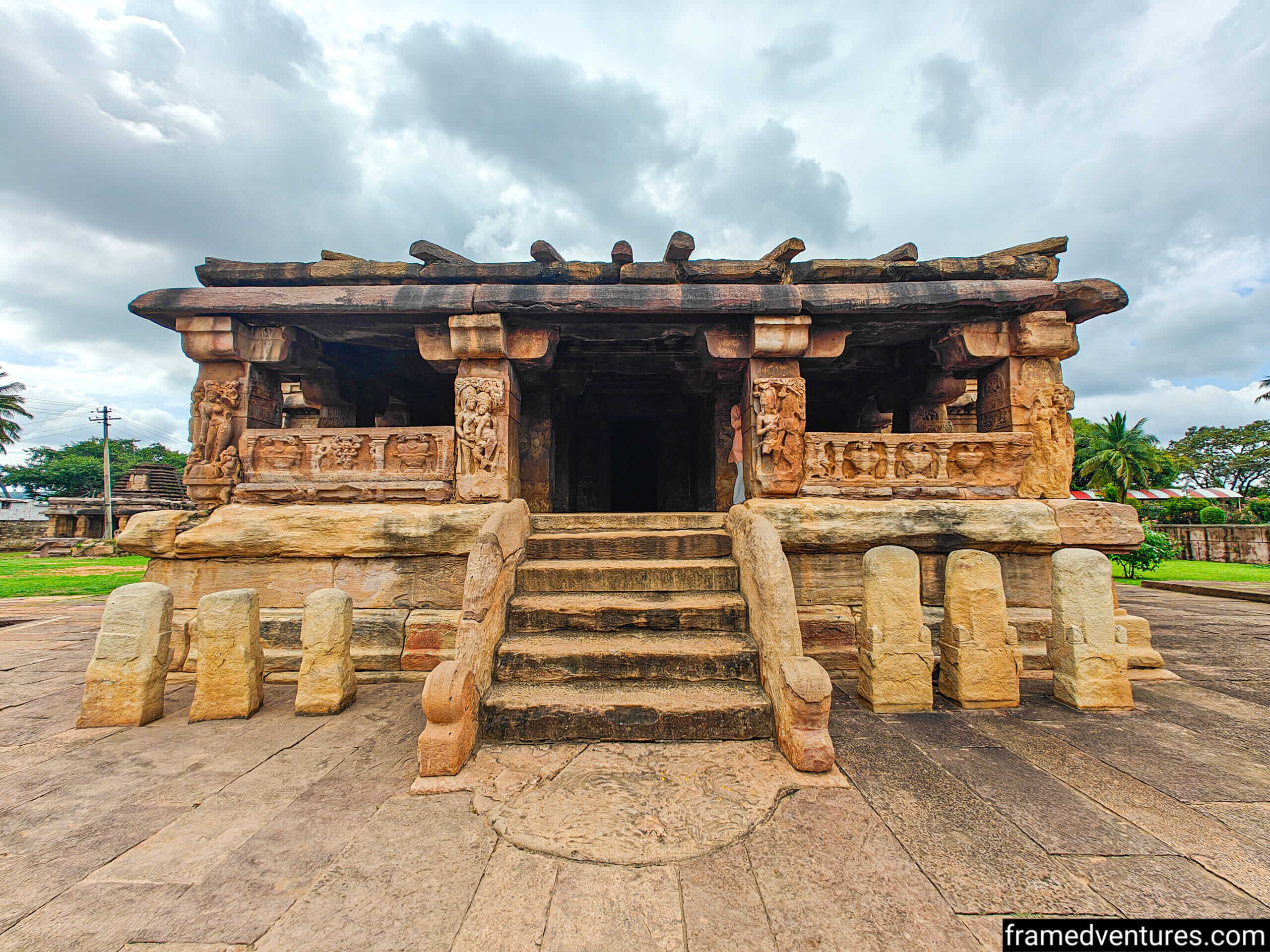
The second most famous temple in the complex is the Chalukya Shiva Temple.
Why?
Because it is the oldest temple in Aihole. Plus, it has a cave-like architecture.
But personally, I found its history intriguing.
Despite being a Hindu Temple, it’s also known as Ladh Khan temple because a Muslim commander of the same name resided here for a brief period.
4. Other temples in the Complex
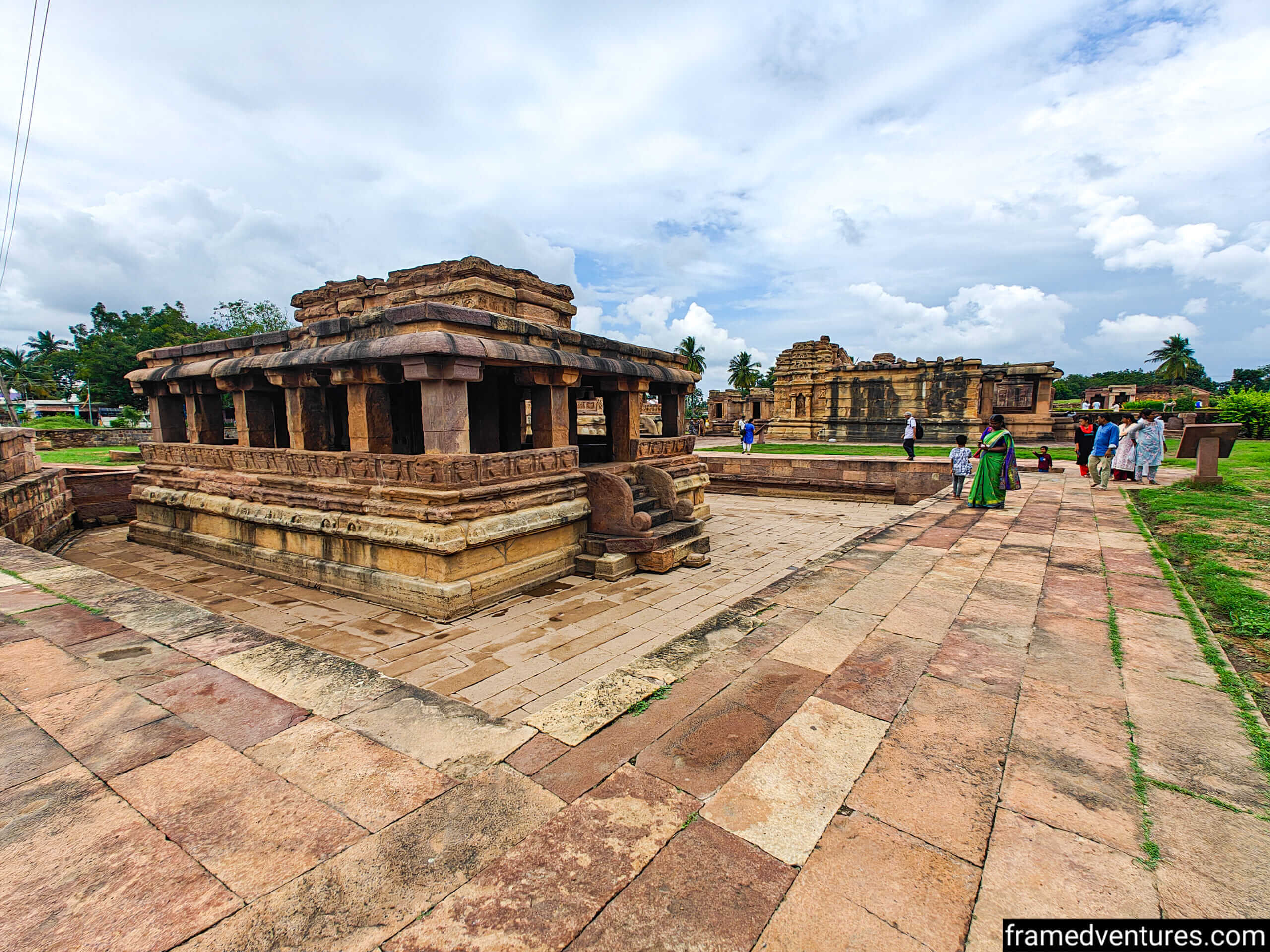
There are a handful of other temples inside the same complex.
Each temple has a unique architecture, dedicated to different deities.
To be honest, I got bored after a while because all of them started looking the same.
However, the information boards came to my rescue.
Every temple has an information board that gives you some interesting historical context behind it.
Moreover, you’ll find ample opportunities for architecture photography.
Some of these temples include:
- Jyotirlinga Temple Group
- Shree Suryanarayana Temple
- Sri Gaudaragudi Temple
You can quickly cover them.
It shouldn’t take more than 1-1.5 hours to finish the entire complex.
5. Meguti Jain Temple: Highest Peak in Aihole
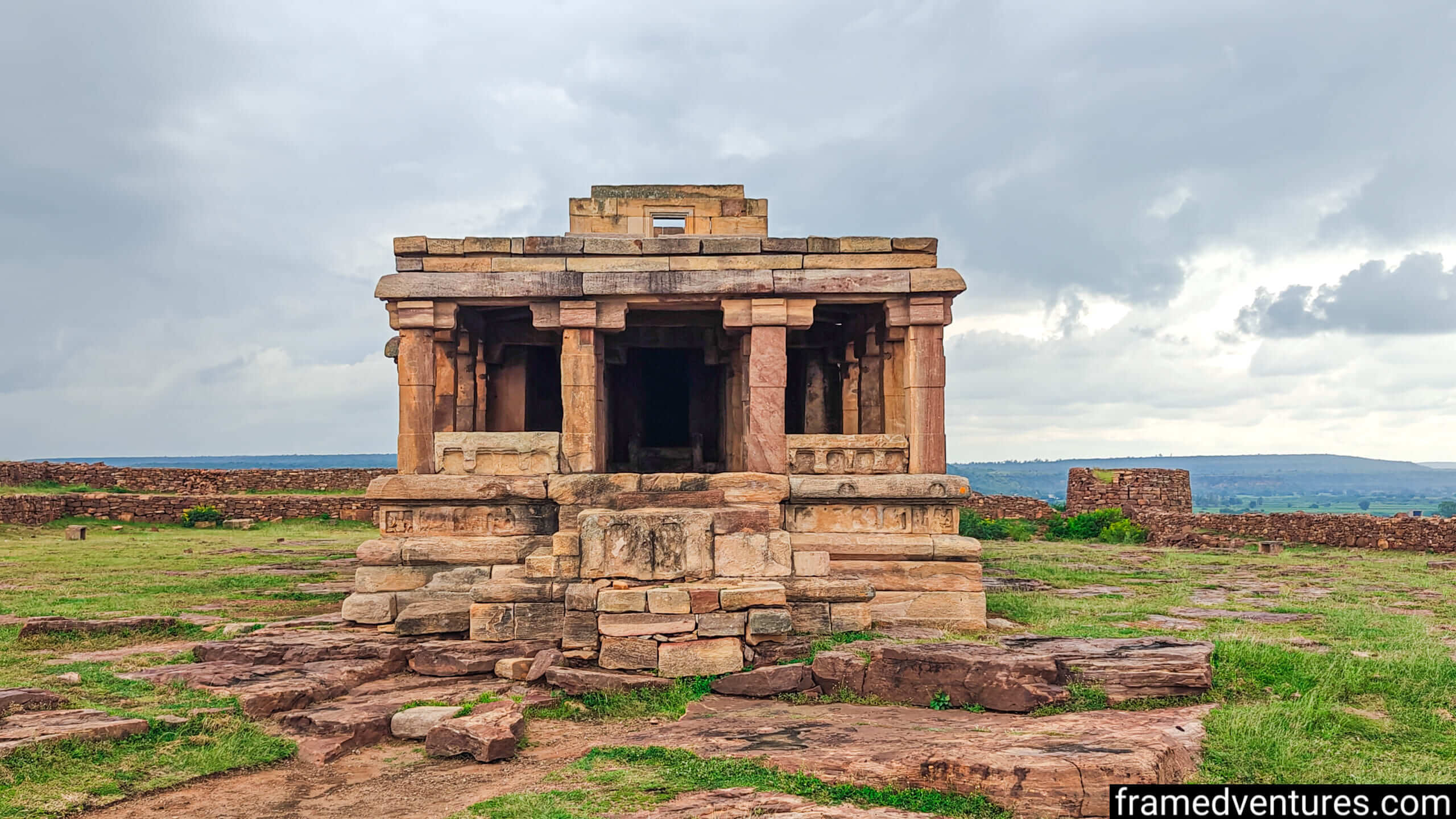
Once you’re done with the temple complex, it’s time to cover the remaining attractions in Aihole. As mentioned before, all of them are within walking distance.
I covered them chronologically in terms of their location. Feel free to follow the same.
Note: The remaining places in Aihole are peaceful but also isolated, as you’ll hardly find any tourists. So be careful of your surroundings while you cover them.
I started with the Meguti Jain Temple, which, as the name suggests, is a Jain Temple, isolated on a hilltop. Beneath the hilltop, you’ll also find a pillared hall.
But more than the temple, I enjoyed the views from the top. It is the highest viewpoint in Aihole open to the public. You’ll get panoramic views in all directions.
However, unlike the Durga temple complex, the Meguti Jain temple is in ruins as there’s no one looking after it.
From the Durga temple complex, it’s a 10-minute walk.
Also, note that you’ll need to climb at least 100 steps to reach the hilltop.
6. Mallikarjuna Temple Complex: Where Nature Meets Architecture
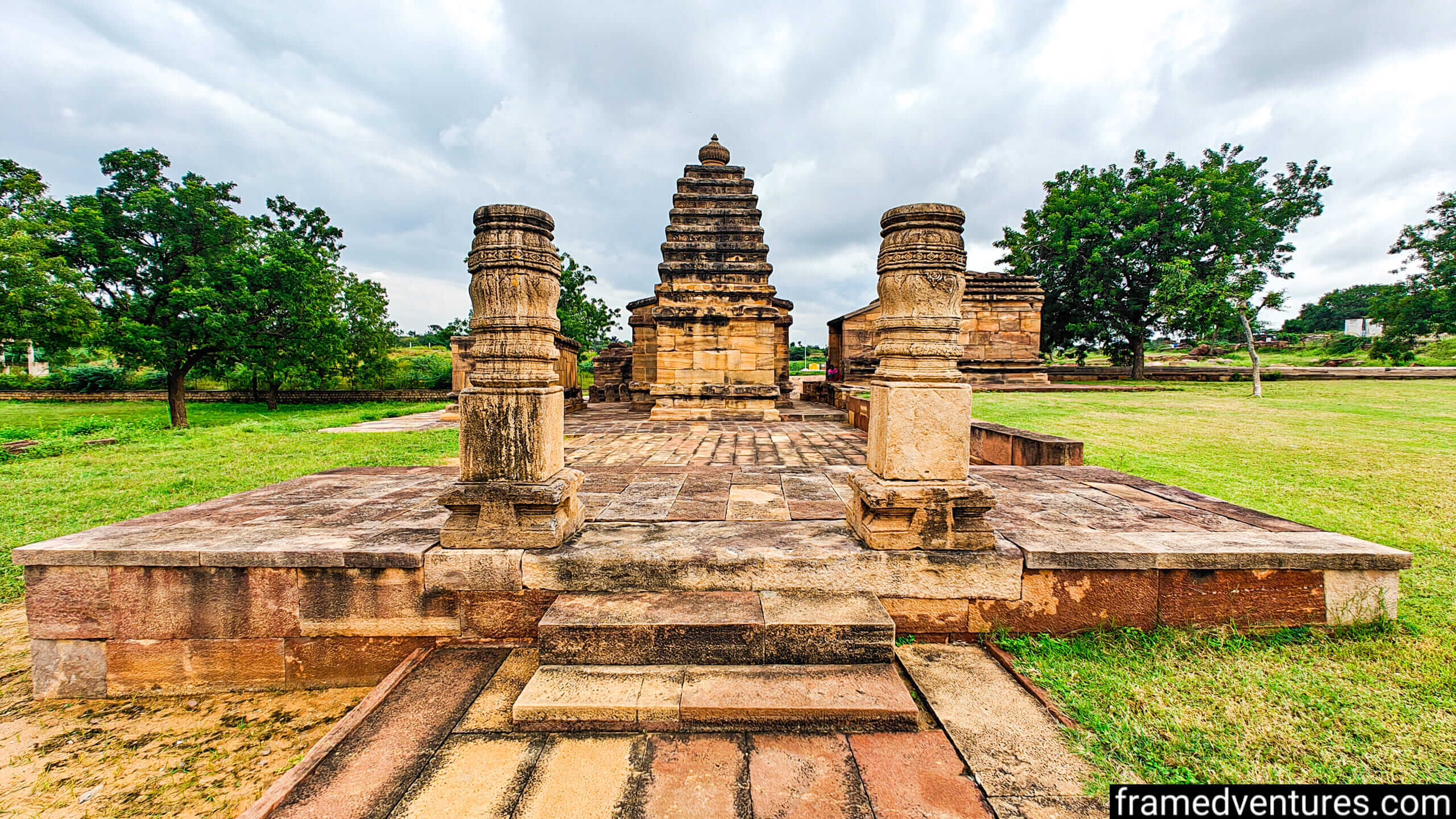
You’ll see this complex on the way to the Meguti Jain Temple.
The Mallikarjuna temple complex has five shrines, spread over a small area with a mini stepwell right in the centre. There’s also a small pond next to its boundary.
This temple is also secluded and peaceful, surrounded by green pastures of land.
And hence, you’ll find numerous opportunities for photography here, especially due to the contrast of nature and architecture.
The gate to this complex remains open with no one guarding it.
7. Ravana Phadi: First Rock-Cut Temple by Chalukyas
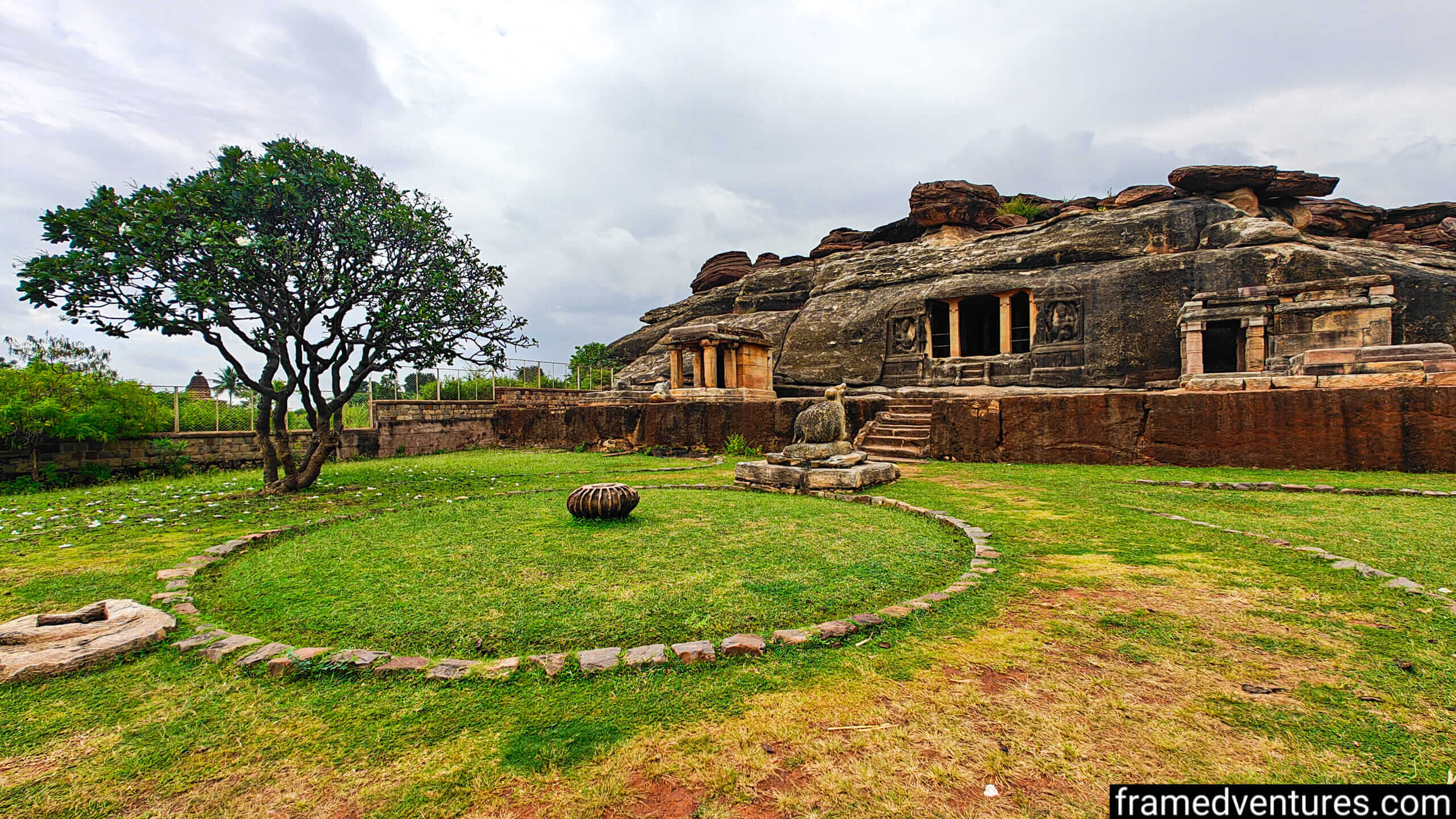
This temple was my personal favourite in Aihole due to its innovative architecture.
Ravana Phadi is carved inside a small sandstone hill at its base.
It is also the first-ever rock-cut temple built by the Chalukyas.
Fun fact: This temple is the inspiration for the cave temples in Badami (more on them later).
Apart from visiting this temple, I recommend climbing the small hill, which takes you to the top. You can sit there in silence while getting a panoramic view of the nearby areas.
Much like the Mallikarjuna Temple Complex, the gate to Ravana Phadi is always open with no one guarding it.
And there are hardly any tourists.
8. Shree Hucchimalli Temple
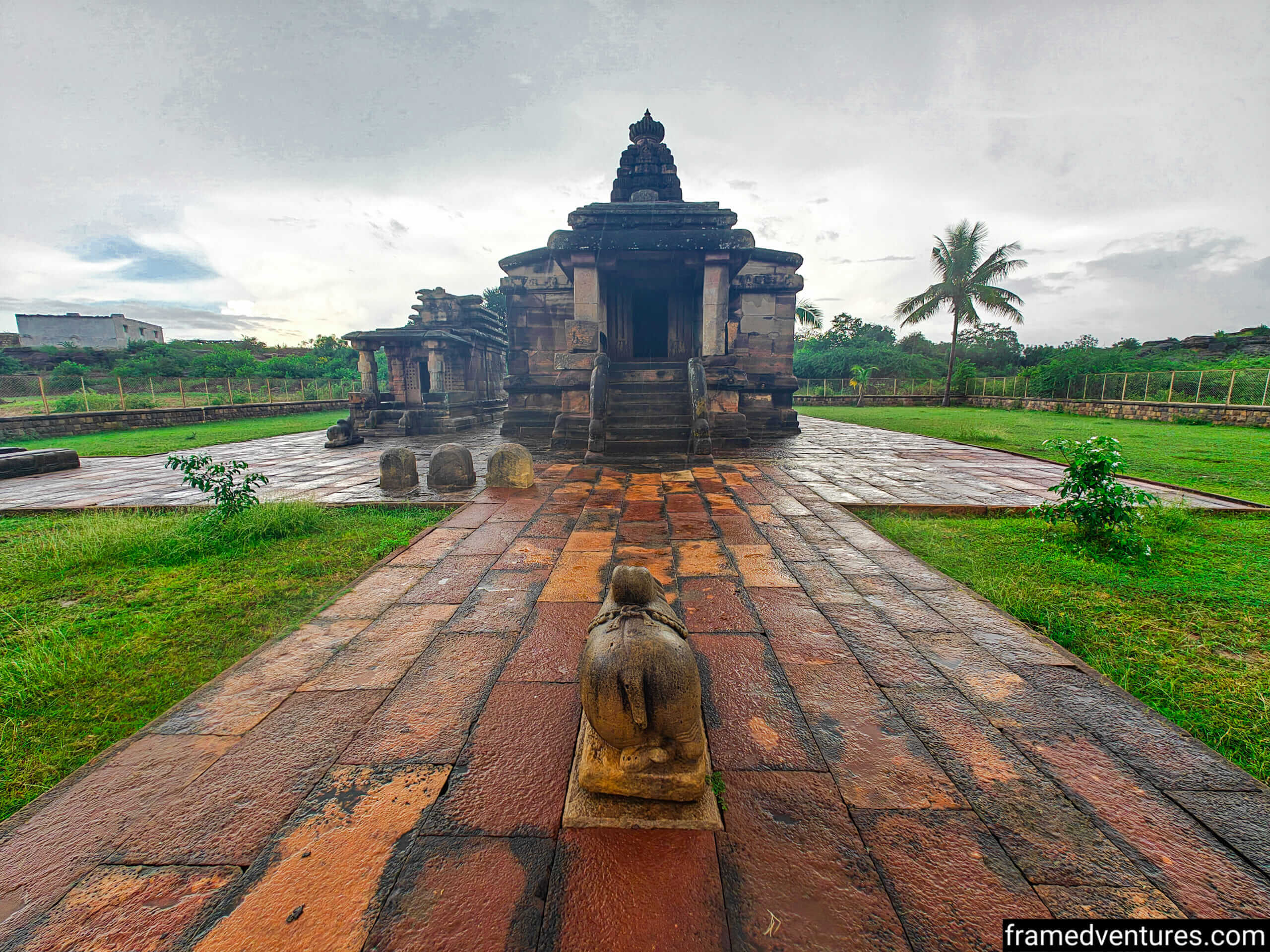
I ended my Aihole trip with this one, which is a complex of 4 temples.
Apart from being an isolated complex, the water tank in the middle of the complex adds to the visual appeal of the overall place.
If you don’t have time, feel free to skip it. But if you do, go for it.
Day 2: Badami and Pattadakal
I covered Badami and Pattadakal on the second day. This may seem like a lot, but it isn’t.
All the attractions in Badami are in one single compound. The same applies to Pattadakal.
Anyway, I started Day 2 with Badami.
But let me give you some geographical context about this place so you can visualise it better.
Have you seen photos/videos of Petra (in Jordan) on Instagram/YouTube?
(Google it if you haven’t!)
Well, Badami looks just like that.
Everything that you see in Badami is either built out of sandstone hills, on top of them, or around them.
1. Badami Cave Temples: India’s Version of Petra, Jordan
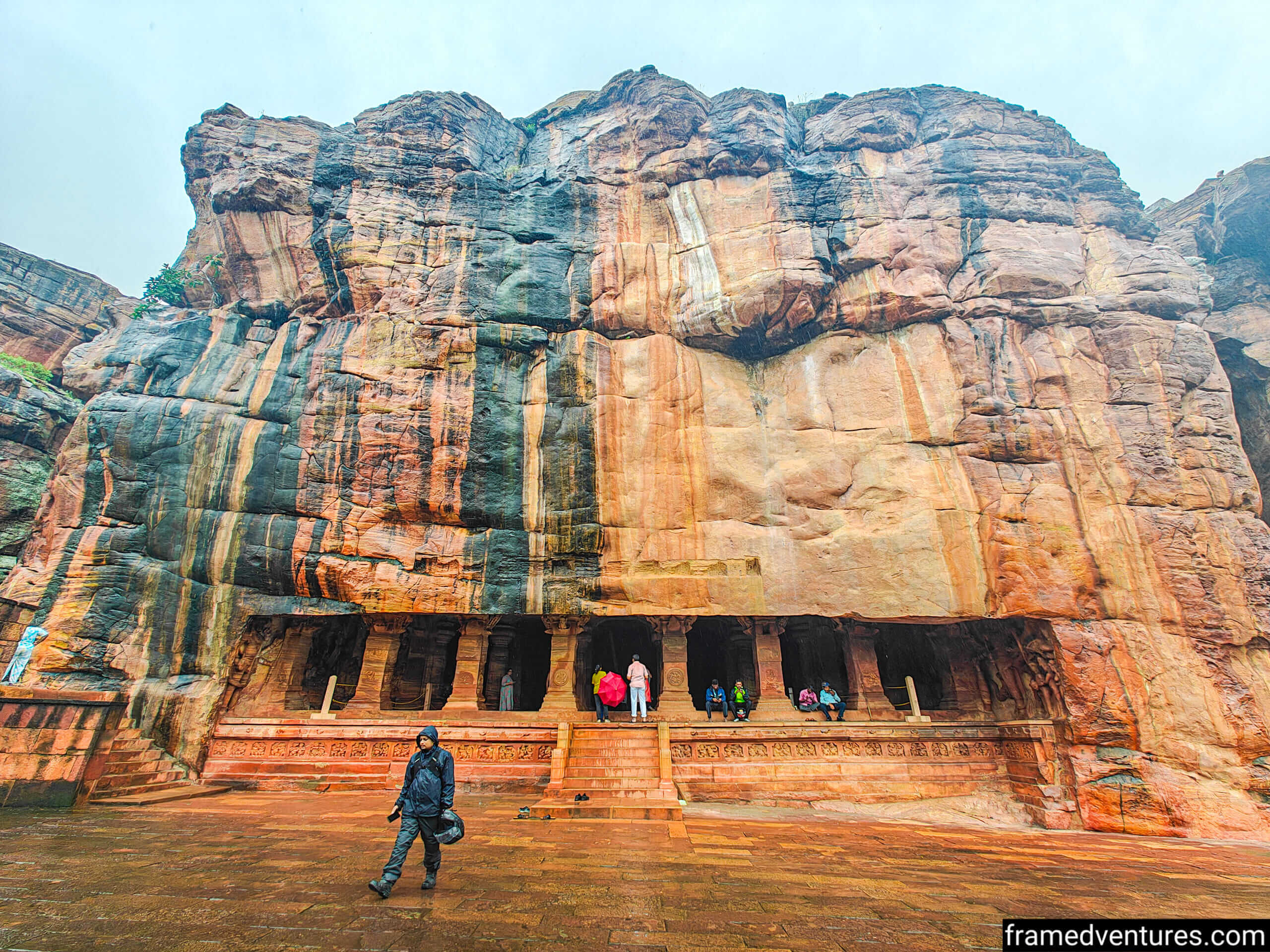
This is the poster boy of Badami!
If you’ve done any research about Badami on the internet, you have seen this place. It’s what forced me to visit Badami.
And thankfully, it lives up to the hype.
As soon as you enter the parking area of this place, you’ll see a massive sandstone hill right next to it.
The Badami Caves are 4 cave-like temples that have been carved into these hills (much like Ravana Phadi in Aihole but grander) in the 6th century.
The first three are Hindu temples, while the last one is a Jain temple. Each temple has detailed inscriptions and sculptures of different deities.
They are all connected by steps, and as you visit each temple, you go higher up the hill.
The best part?
As you go higher, you’ll get a bird’s eye view of the Agasthya Lake, a few temples, and some cliffs nearby.
You can also see the Badami Fort, which is located far away on top of a hill, in the opposite direction from the Cave Temples.
Fun Fact: If you visit Badami during/post-monsoon, you’ll also notice a waterfall plunging from the top of a nearby cliff.
In other words, if you’re a landscape photographer, you’ll love the different perspectives from here.
In total, it may take up to 1.5 hours, depending on your speed.
You need to pay a small fee to enter this place.
Also, note that official guides are available in case you need more context about the temples and other places in Badami. I didn’t hire one because I found their charges unreasonable.
The temples are open from 6:00 AM to 6:00 PM.
FYI – Even though I arrived here late in the morning, the best time to go is during sunrise due to fewer crowds, pleasant weather, and the perfect lighting for photography.
2. Archaeological Museum at Badami
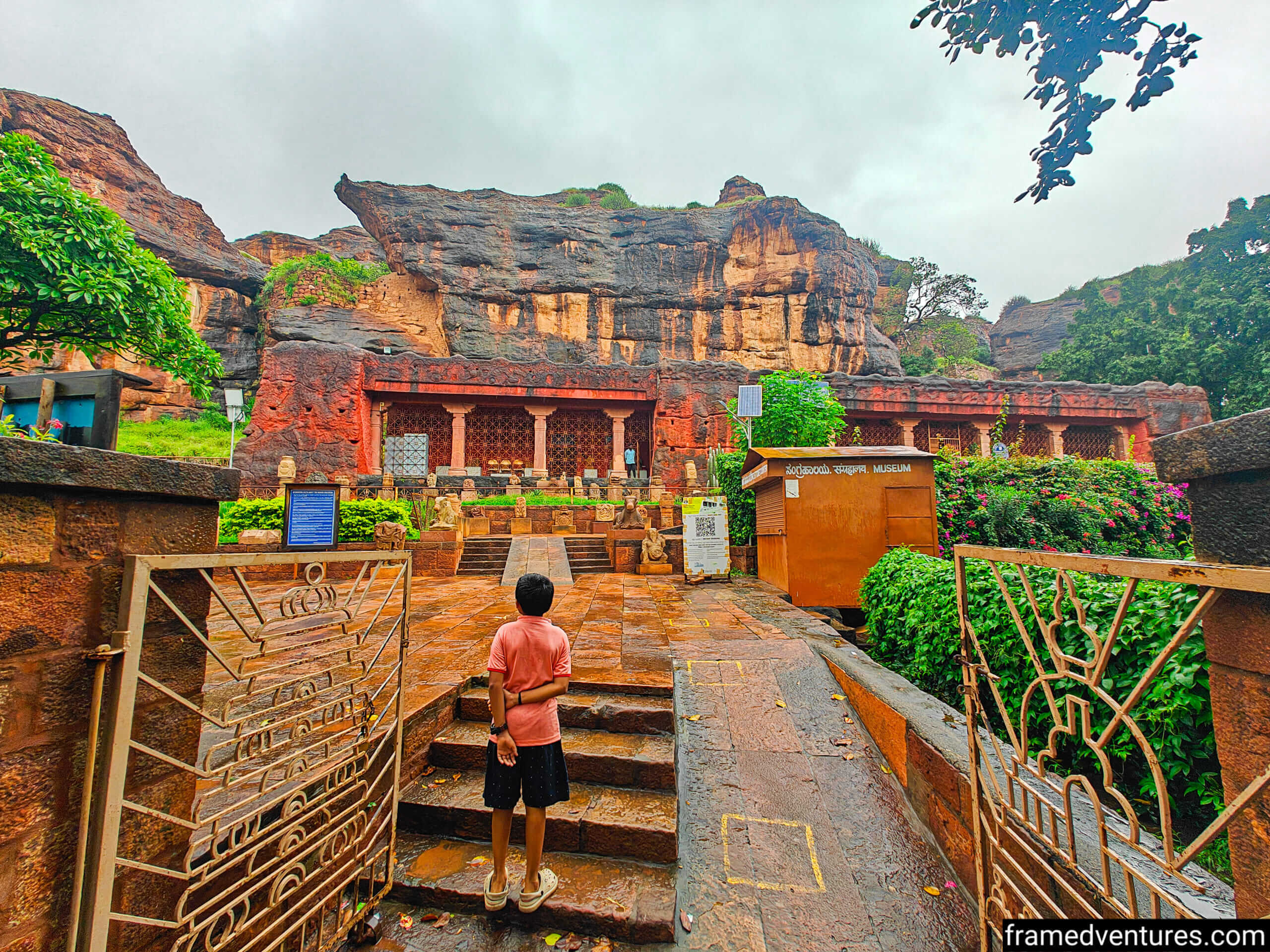
After the cave temples, you can make your way to the museum.
I missed the museum as I went on a Friday—the only day it is closed to the public.
Here, you’ll find a collection of artefacts and sculptures from Badami, Pattadakal, and Aihole, like what you saw in the Aihole museum.
Photography is not allowed inside the museum.
It’s open from 9 am to 5 pm on all days, except Fridays.
3. Sri Mallikarjuna Gudi
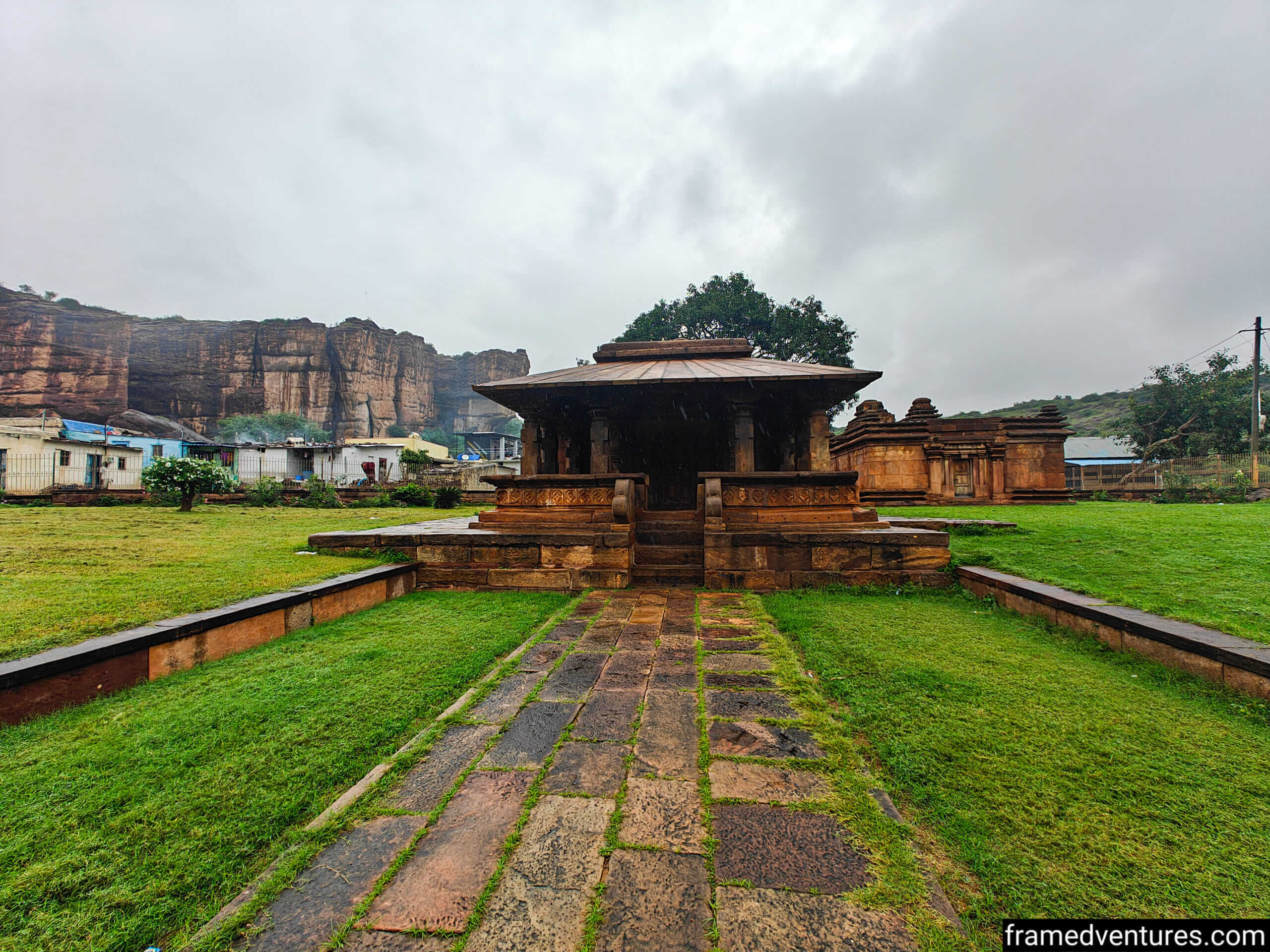
Sri Mallikarjuna Gudi is an abandoned Hindu temple on the way to Sri Bhootanaatha Gudi.
There’s nothing much to see here, as it looks like any other temple you’ve seen before.
You can give it a quick visit and head to Sri Bhootanaatha Gudi.
No tickets are required for this place.
4. Sri Bhootanaatha Gudi: A Peaceful Lake Temple
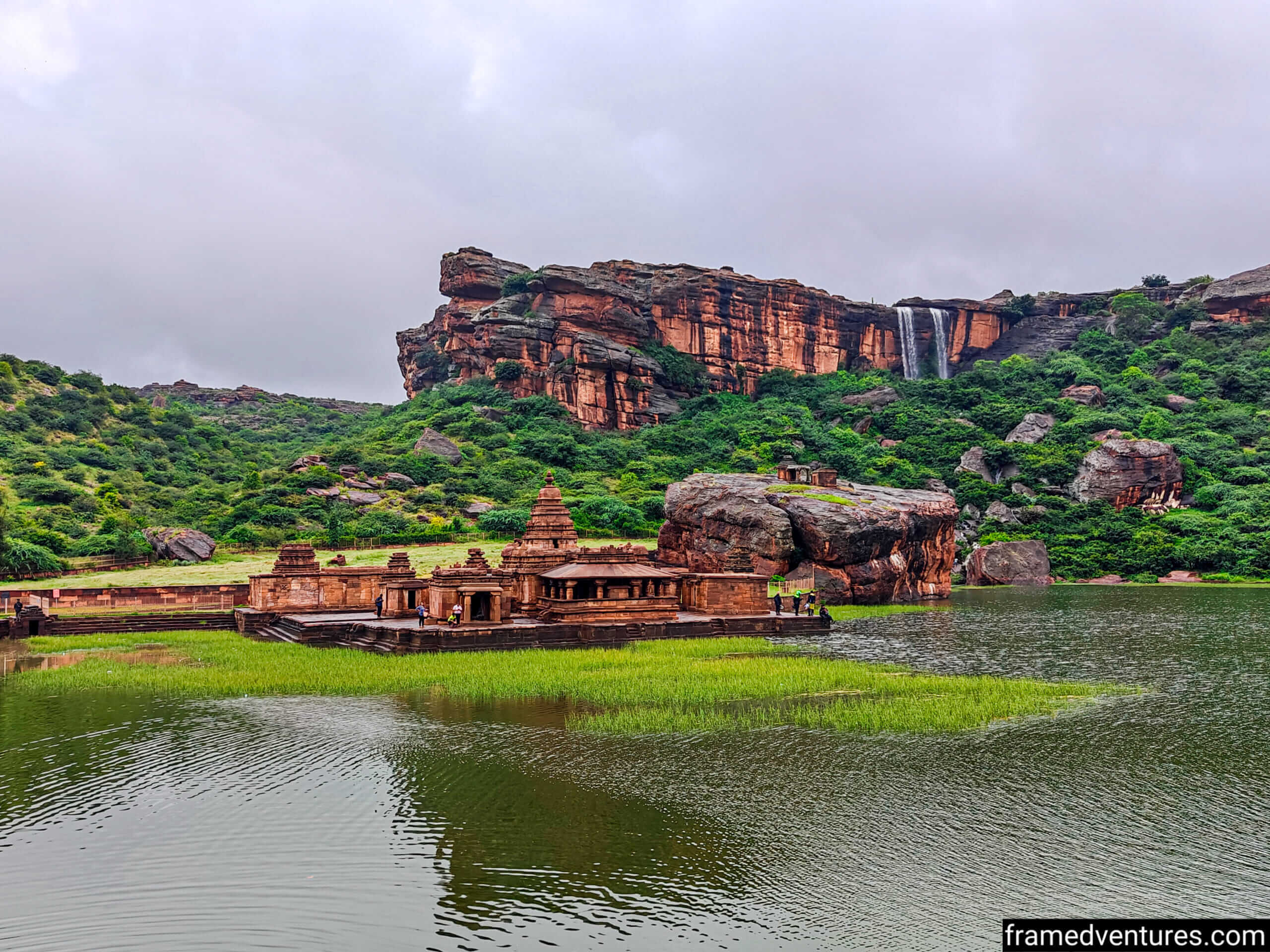
Sri Bhootanaatha Gudi is another highlight of Badami.
Much more than the temple itself, I enjoyed the overall scenery of its location.
With a cliff in the background, it’s surrounded by Agasthya Lake on three sides, as you see the temple’s reflection in the lake.
Moreover, it’s relatively peaceful and less crowded, so you can spend some time sitting here admiring the overall landscape.
Sunrise and sunset are the best times to visit this place.
There’s no entry fee.
5. Badami Fort: A Hike To History
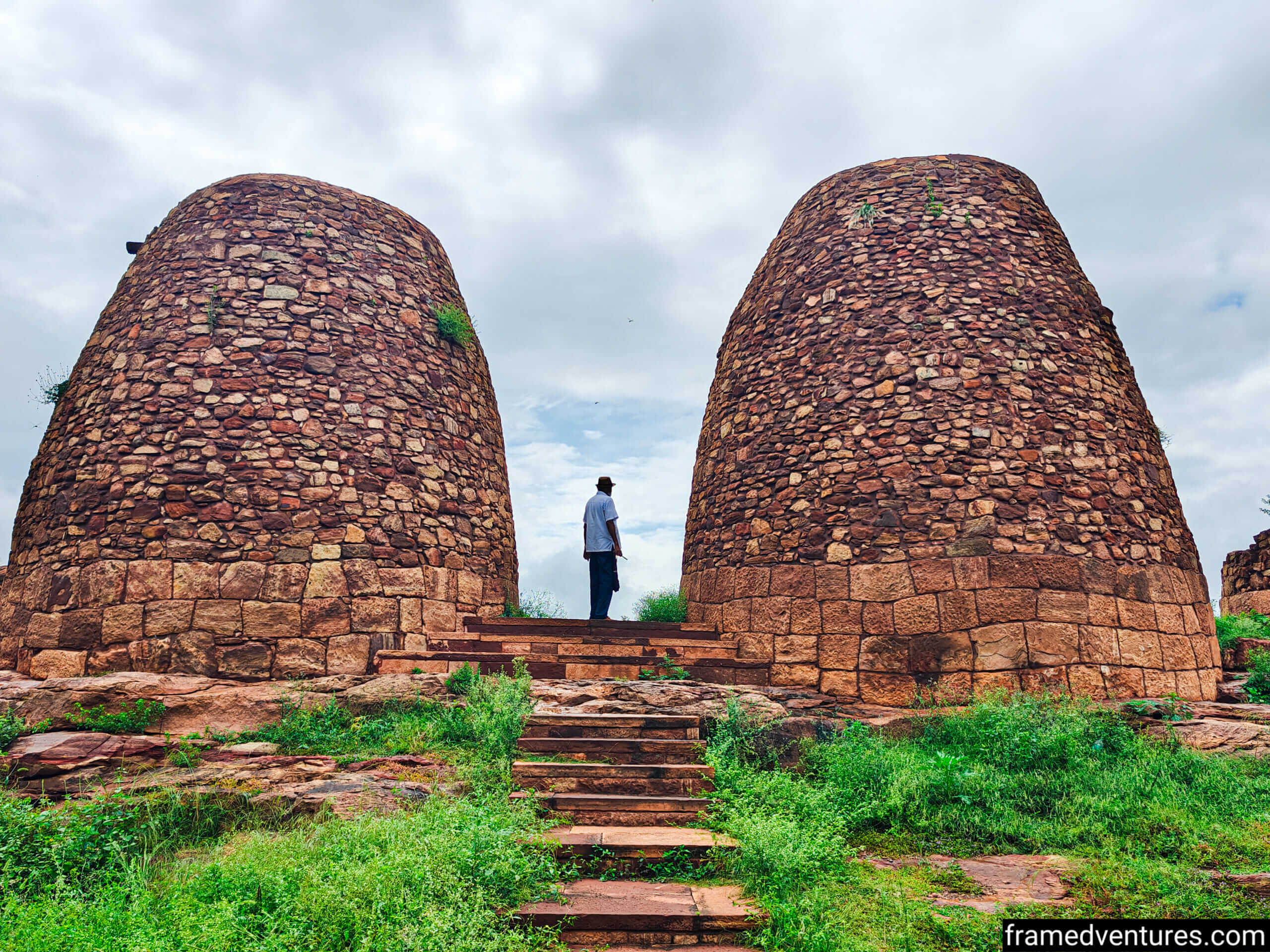
Many people skip this, but I highly recommend that you do not.
I found it particularly adventurous because there’s so much to explore here. It was like playing a treasure hunt.
As the name suggests, the Chalukyas built this fort around 540 AD on a hilltop overlooking Badami town. Tipu Sultan rebuilt/modified it later during his reign.
It’s not just a fort, though.
You’ll see watchtowers, cannons, granaries, gateways, prisons, and other such ruins in the complex.
(There are a couple of temples as well, which I’ll cover in the next point.)
And that’s not it!
From the top, you’ll get a bird’s eye view of Badami town on one side and Agasthya Lake, Cave Temples, and some cliffs on the other.
Lastly, the entire hike is fun as well. You’ll be walking in the middle of huge cliffs and boulders, finding your way to the top.
It’s impossible not to stop for photography every 5 minutes at this place.
The trek to the fort starts alongside the archaeological museum, and there’s no entry ticket. The initial climb is full of rugged terrains and cobbled pathways, while the hilltop is just nature taking over the ruins.
It can easily take up to 2 hours, given how there’s so much to do.
Note: While it’s peaceful, it can get lonely here, especially at the top. Also, be careful of the monkeys present here.
6. Shivana Gudi: Temples With A View
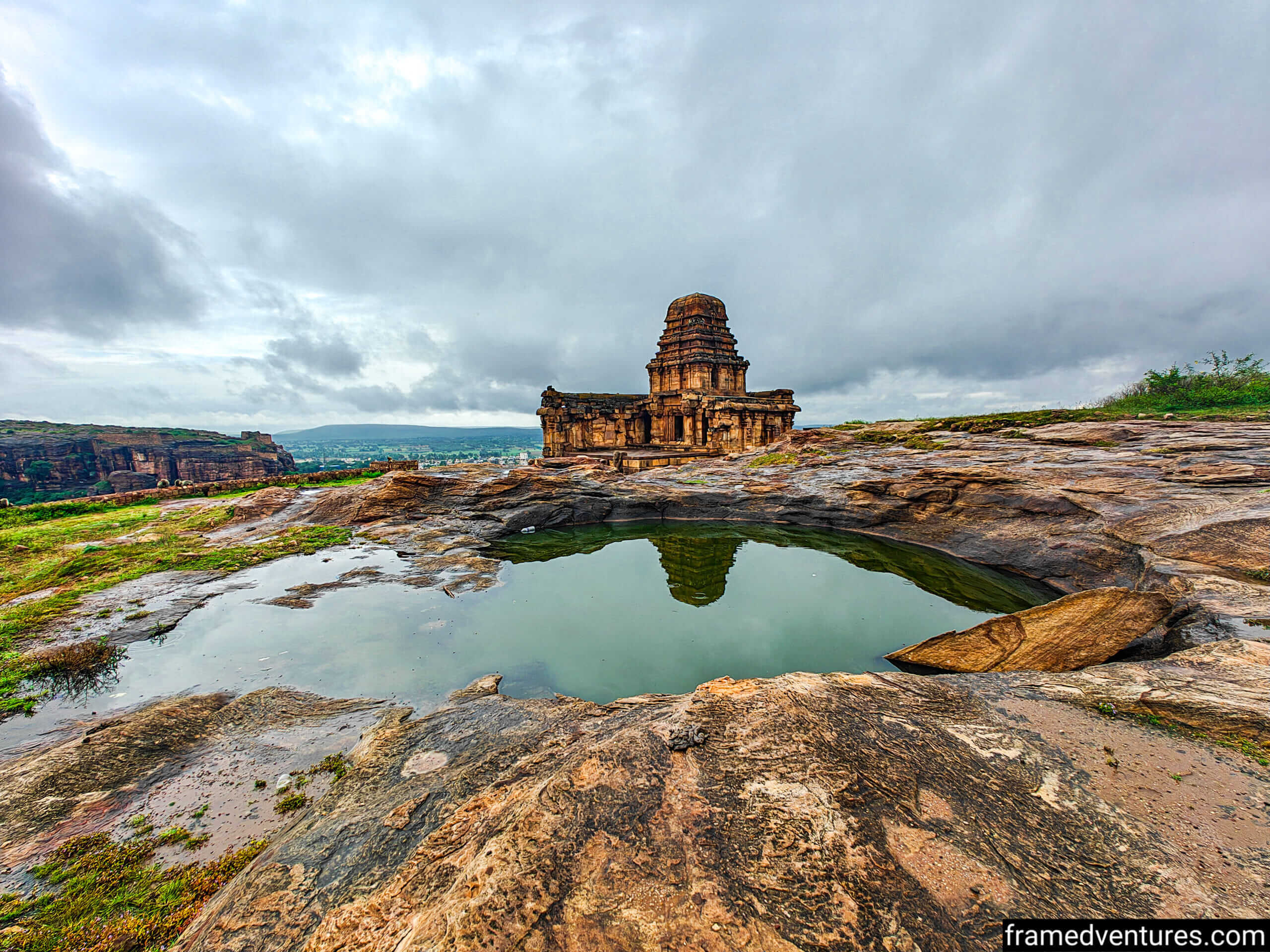
These are two temples on the hilltop within the premises of Badami Fort – Upper Shivalaya and Lower Shivalaya. Lower Shivalaya comes in between, while Upper Shivalaya is at the top.
But much more than the temples themselves, I loved the surrounding scenery and landscapes.
For example, you’ll get a panoramic view of Badami town at different elevations from these temples. Plus, you’ll find many other scenes in between as you walk towards them.
Although these temples are part of the fort, they’re located in different areas. And it can be easy to get lost as there are no signboards.
For that reason, I suggest you use Google Maps to find your way or ask people for directions. Even otherwise, you’ll do just fine if you follow the trails that already exist there.
7. Pattadakal: The Only UNESCO World Heritage Site
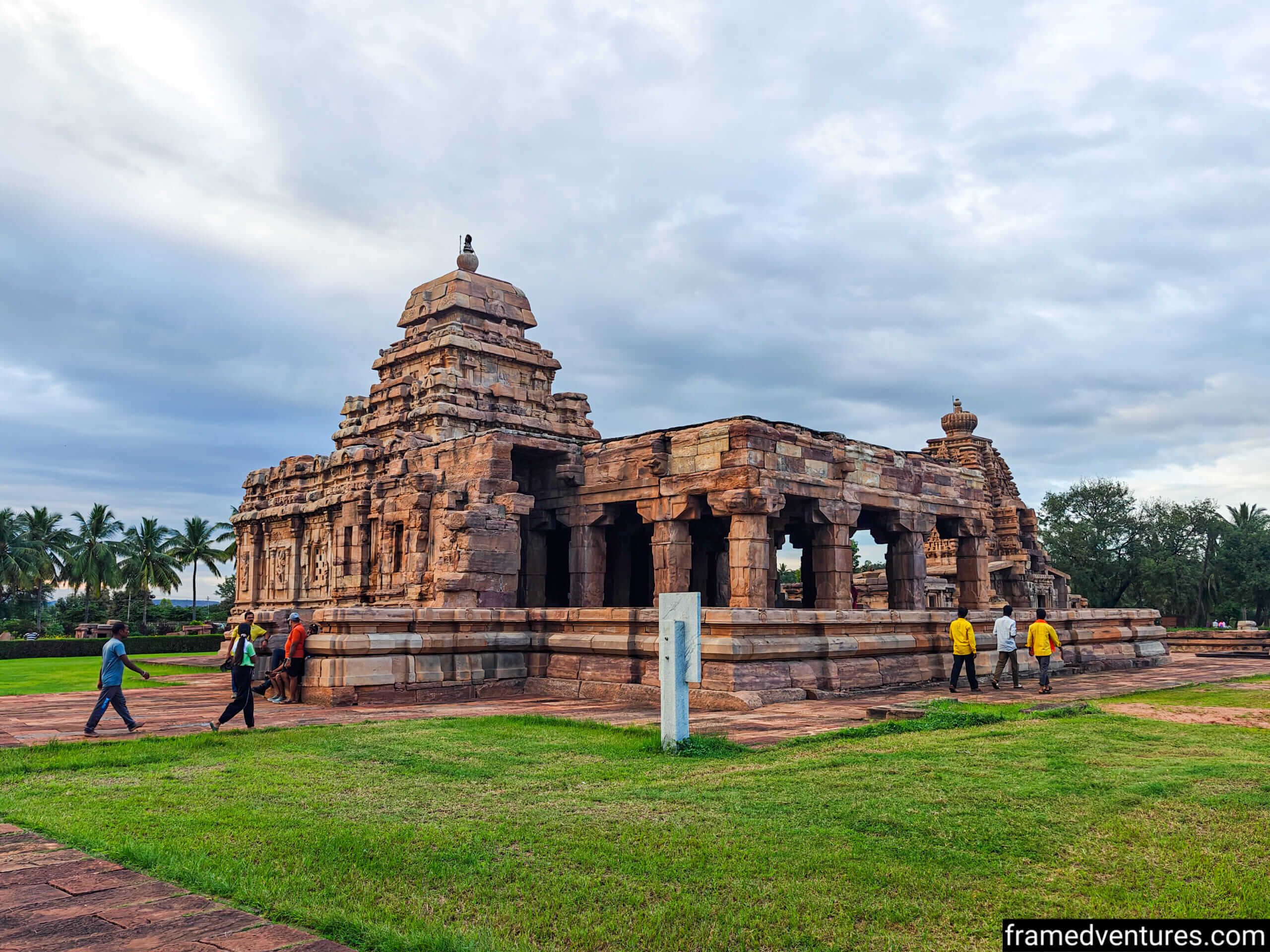
It was around 2 pm by the time I finished Badami.
After having lunch in the town, I took a bus to Pattadakal.
(I don’t recommend buses btw as I had to wait more than an hour.)
Anyway, I thought I wouldn’t be able to cover Pattadkkal in one go as I reached there only by 4 pm.
But surprisingly, I wrapped everything up within 2 hours.
How, you ask? Let me give you some context first.
Out of the three places, Pattadakal is the only UNESCO World Heritage Site.
There are ten temples at Pattadakal–nine Hindu and one Jain, all of which are in one compound.
And if you have already seen the temples at Aihole and Badami, Pattadakkal will look more or less the same, although there are some differences in terms of architecture and carvings.
Plus, you’ll also find information boards for each temple, which will give you some context.
But the main reason I spent 2 hours at Pattadakal was that you’ll find many opportunities for architectural photography. The temples are inside a well-maintained garden with a backdrop of blue skies.
Some of the famous temples here include:
- Kadasiddheshwara temple
- Jambulingeshwara temple
- Galaganatha Temple
- Chandrashekhara Temple
- Sangameshwara Temple
- Kashi Vishwanatha Temple
- Trailokeshwara Temple
- Virupaksha Temple
- Papanatha temple
- Jain Narayana Temple
You need to buy one ticket to visit all these places from the counter.
The (Only) Stay I Recommend in Badami
I searched long and hard for a good homestay in Badami.
There was only one I could find. And it is the only one I recommend if you plan to visit Badami.
(Btw, you can find hotels in Badami too, but I generally prefer homestays, especially when I’m travelling solo.)
Dharani Farm and Homestay
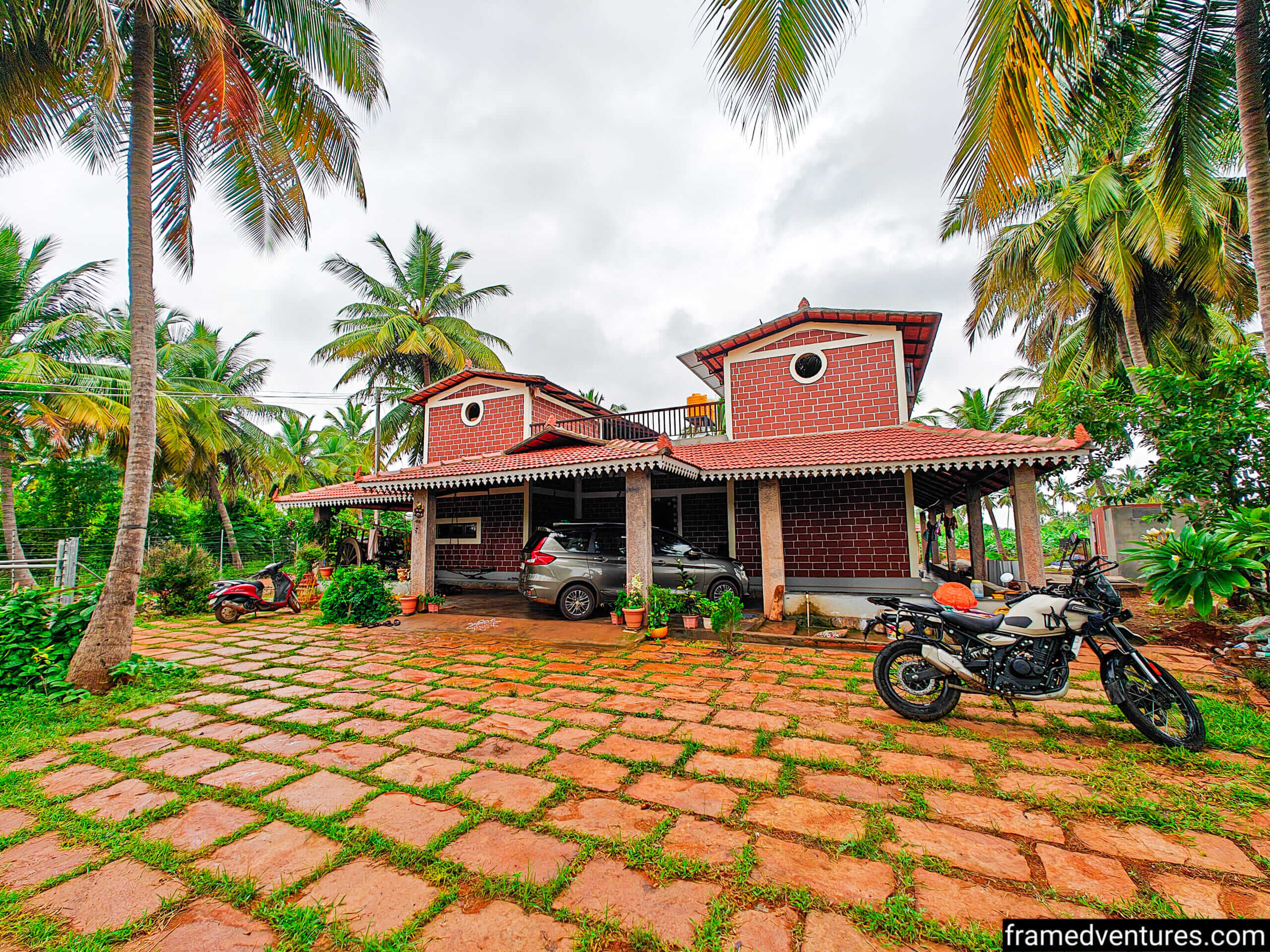
I’m not exaggerating when I say this:
If not for Manjunath and his wife, this trip wouldn’t have been possible.
No, seriously. It felt like a home away from home.
Beginning with the food at the homestay, every time I had breakfast or dinner, my taste buds were jumping around.
You’ll experience authentic and organic North Karnataka cuisine.
Then comes the hospitality.
Manjunath helped me plan my itinerary and even provided me with a bike to travel around Badami (ask him if you need one).
I also spent some time with him talking about his decision to move from Bangalore to Badami and how he built this homestay. You should, too.
Lastly, you’ll love the location of the homestay.
It is nestled inside a farm, 10 minutes from Badami. It’s so isolated that you’ll only hear the sounds of nature and people inside the house.
But that also turns out to be the only con of this otherwise wonderful homestay.
You have to rely on Manjunath (or his helpers) to pick up or drop you from/at Banashankari Temple junction, the last end of Badami.
From there, you won’t get public transport to the homestay. I mean, technically, you can hire an auto, but those folks charge you a bomb.
So, relying on Manjunath is the only option.
My Favourite Restaurant(s) in Badami
Despite being a remote area, you can find a bunch of restaurants in Badami, especially near the bus stand.
I only visited one because I didn’t have time.
Here are the ones I suggest:
1. Sri Veerabhadreshwar Lingayat Khanavali
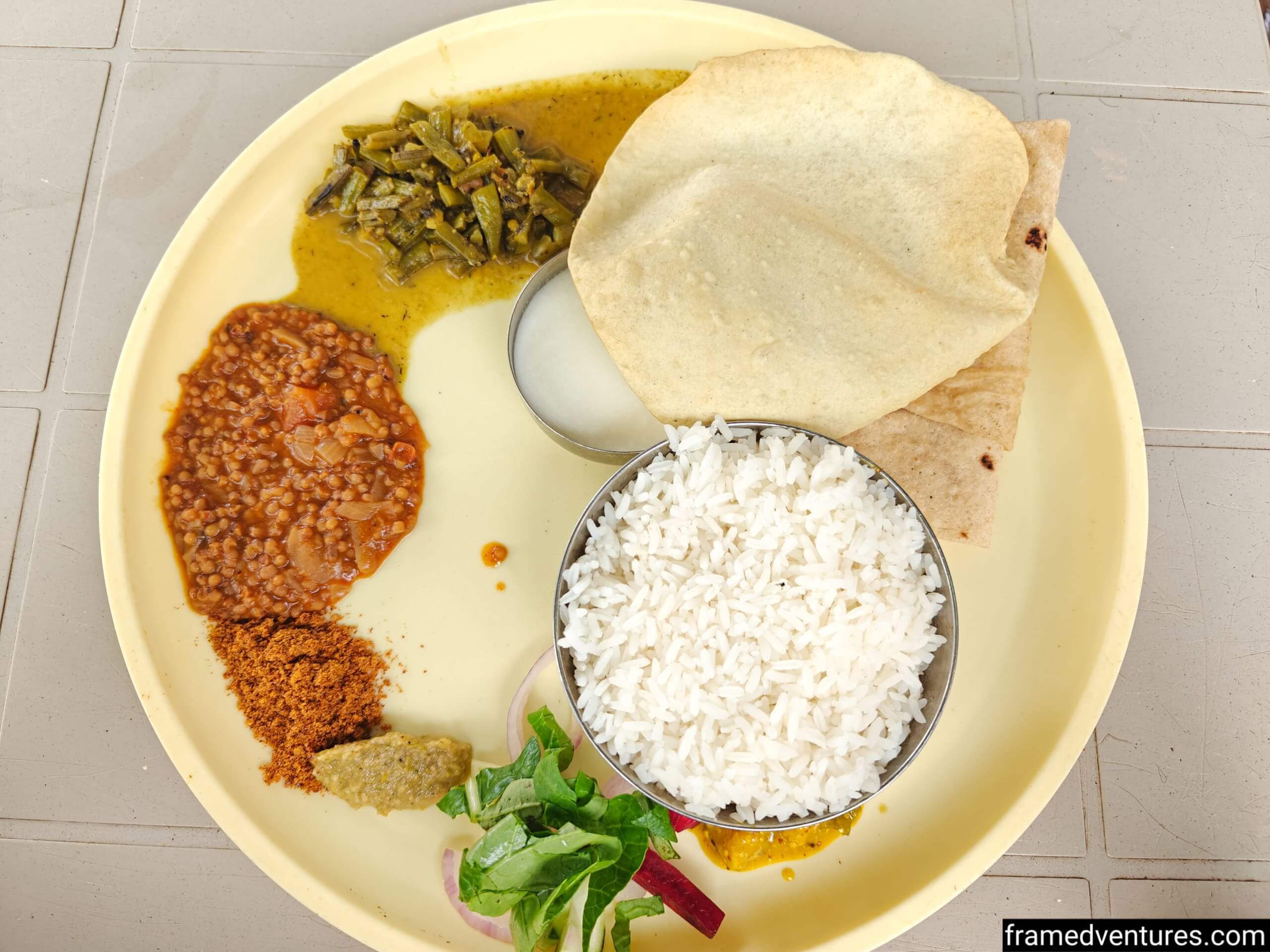
This small, unassuming restaurant delivers big time with its authentic, North Karnataka-style thali.
As part of their thali, they offer rice, roti, curry, chutney, curd, papad, pickles, sambhar, and sweets.
I still remember the taste as if I had it yesterday because it felt like my mom made it.
The best part? You can ask them to refill your plate till you feel full.
The icing on the cake is that it costs only INR 10,0 and the service is great.
You can visit this place near the Badami bus stand.
2. Hotel Sri Gurubhavan, Badami
3. Krishna Bhavan
How to Reach Badami?
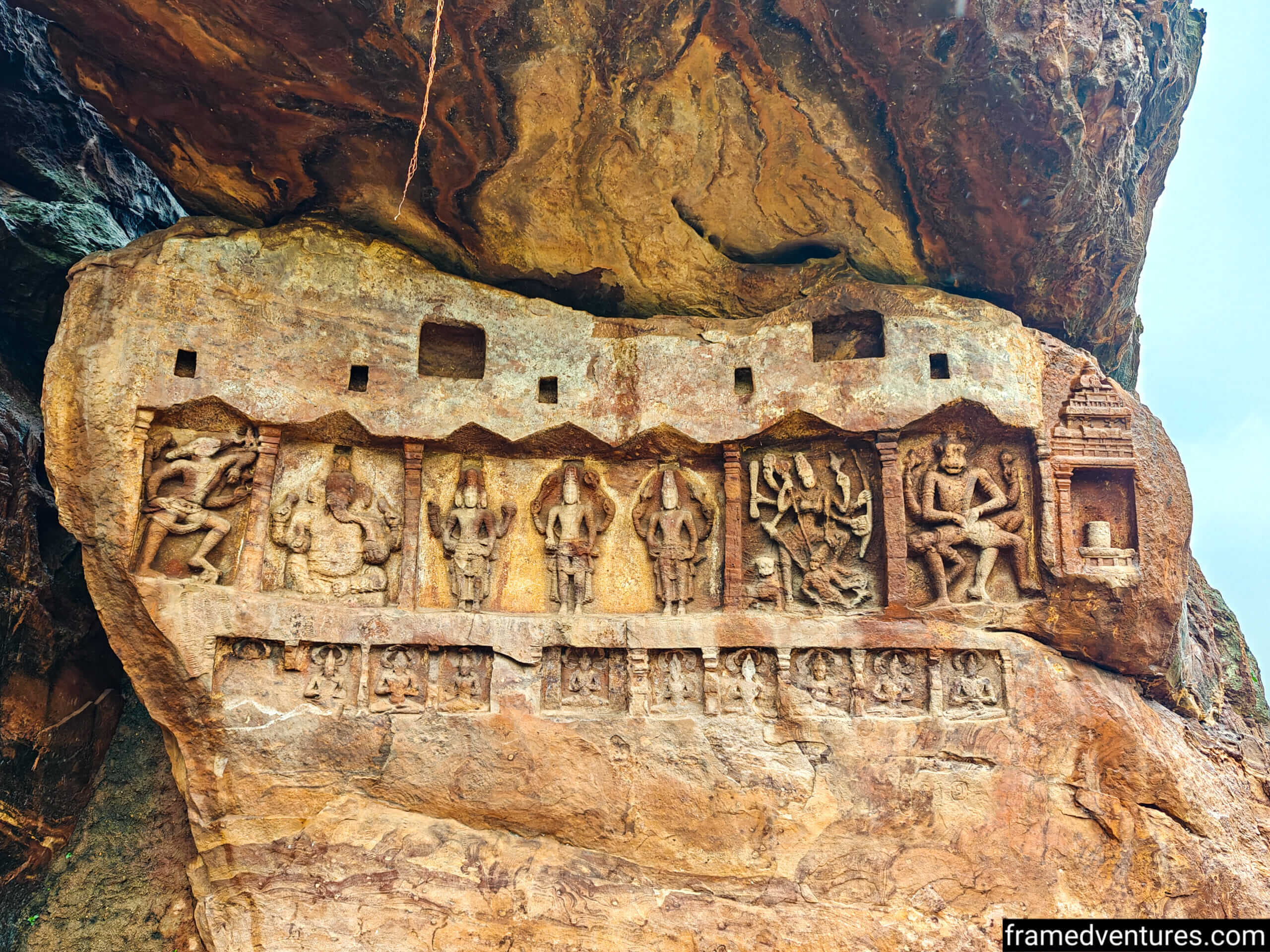
Start your journey from Bangalore, as you’ll find many options to travel to Badami.
I boarded the Yesvantpur-Vijayapura Daily Express Special (Train No. 06545).
Out of all the trains, it’s the only one I recommend as it starts at 21:30 from Bangalore and reaches Badami by 8:37 in the morning.
If you’re unable to book the train, your second-best option would be to book an overnight bus from Bangalore. You’ll find both private and government buses.
How to Travel within Badami?
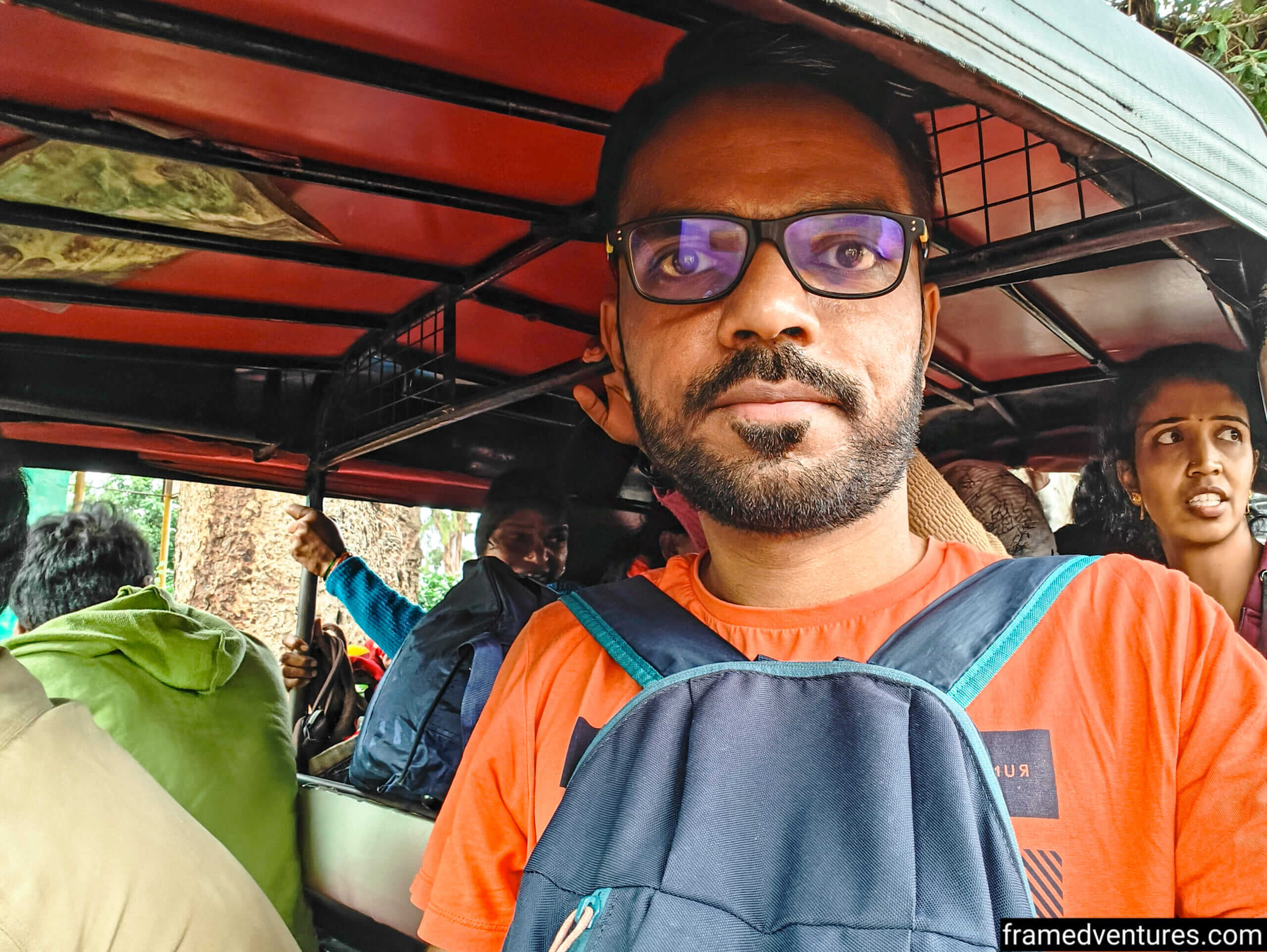
If you’re travelling within Badami town, you can rely on the shared autos. If you plan to visit Pattadkal or Aihole, buses are available, but their frequency is less.
In both cases, ask your stay for the timings and the stops beforehand.
Another option is that you can hire private autos with the help of your stay. Usually, every stay will have some tie-up. But note that this will be costly.
The best option, however, is to rent a bike. This option was available at my homestay, but I’m not sure if it’s common practice in Badami.
Best Time to Visit Badami
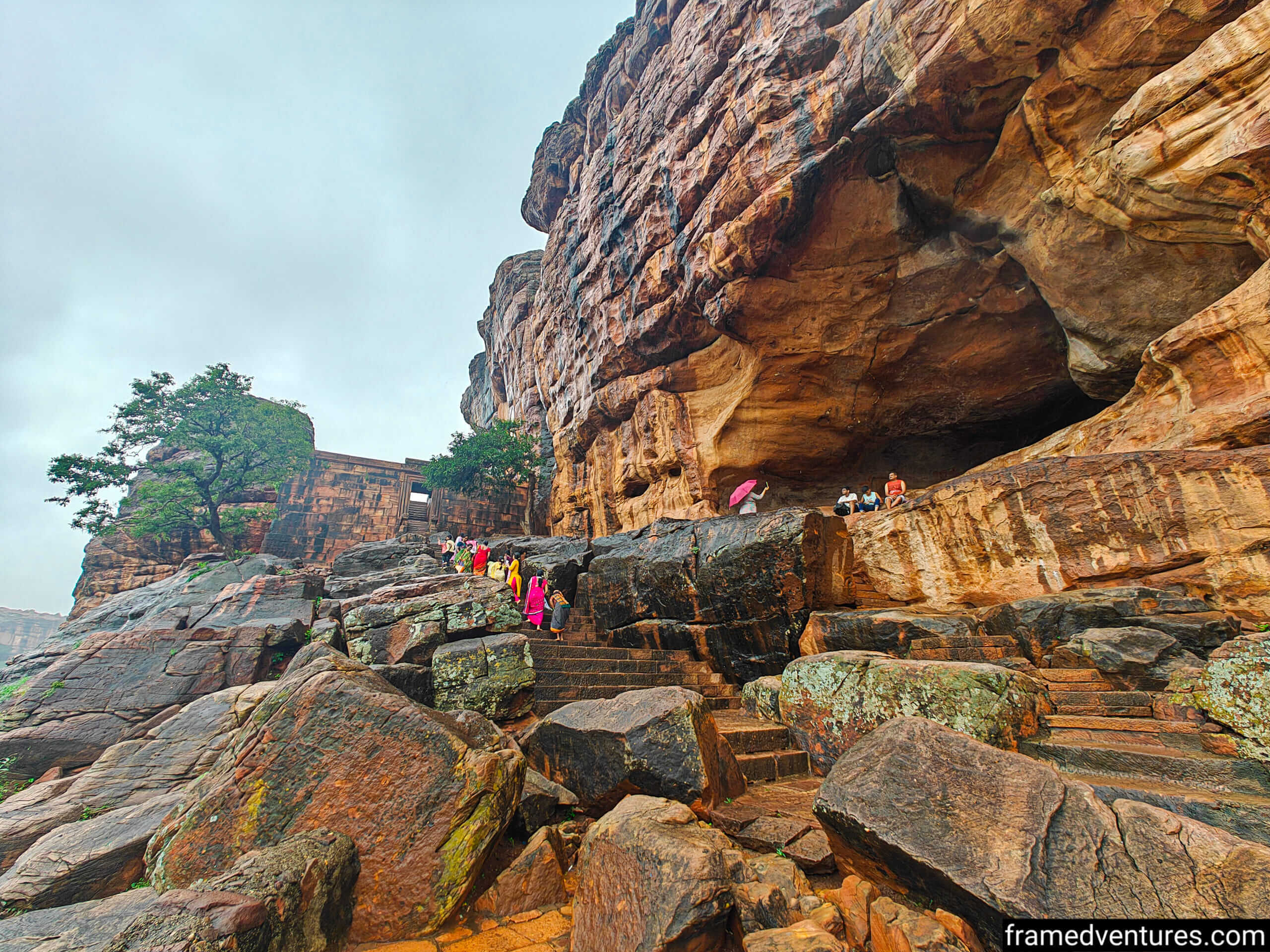
North Karnataka, as per my homestay owner, is generally dry and hot.
So, I suggest you avoid the summer season, which is somewhere between April to July.
I went in September. Apart from the drizzles, the weather was pleasing in general.
7 Useful Tips for Badami-Aihole-Pattadakal
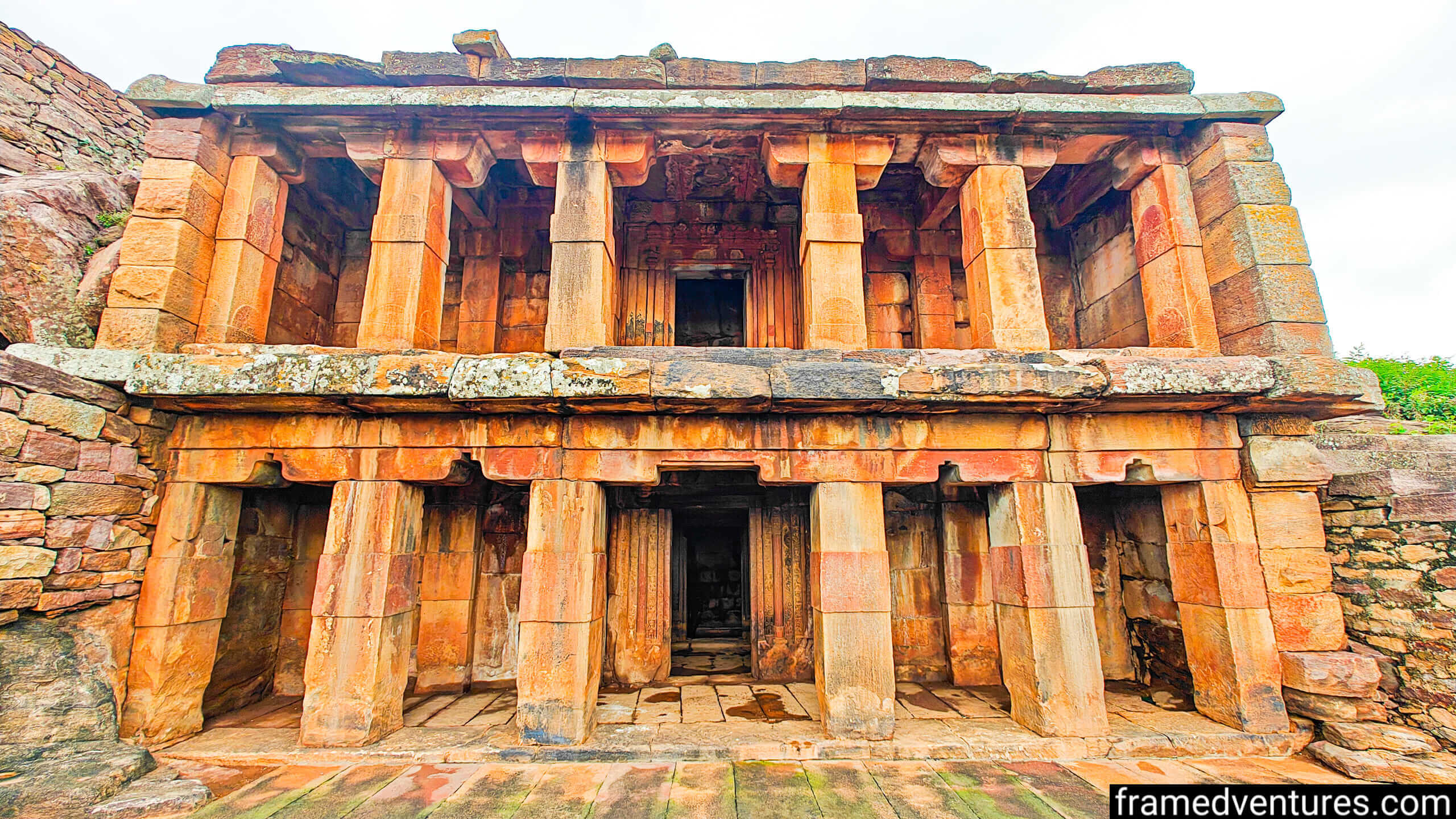
Keep these things in mind to have a comfortable trip to Badami.
1. Book a stay where the staff speaks Hindi/English because the locals mostly speak Kannada.
2. To enjoy the weather, wear shorts, tees, and sports shoes/sandals.
3. Carry a water bottle, hat, and shades to bear the heat.
4. You can hire a guide if you need more context behind the temples, but it can get costly. Consult your stay for recommendations.
5. Be careful of the bats and the foul smell inside the deeper end of the temples.
6. Beware of your belongings when you go to isolated places, as monkeys are common.
7. While you’ll find roadside eateries in Aihole and Pattadakal, you don’t want to risk food poisoning. For that reason, I recommend carrying dry fruits, fruits, and snacks.
Visit Badami Only For These 2 Reasons
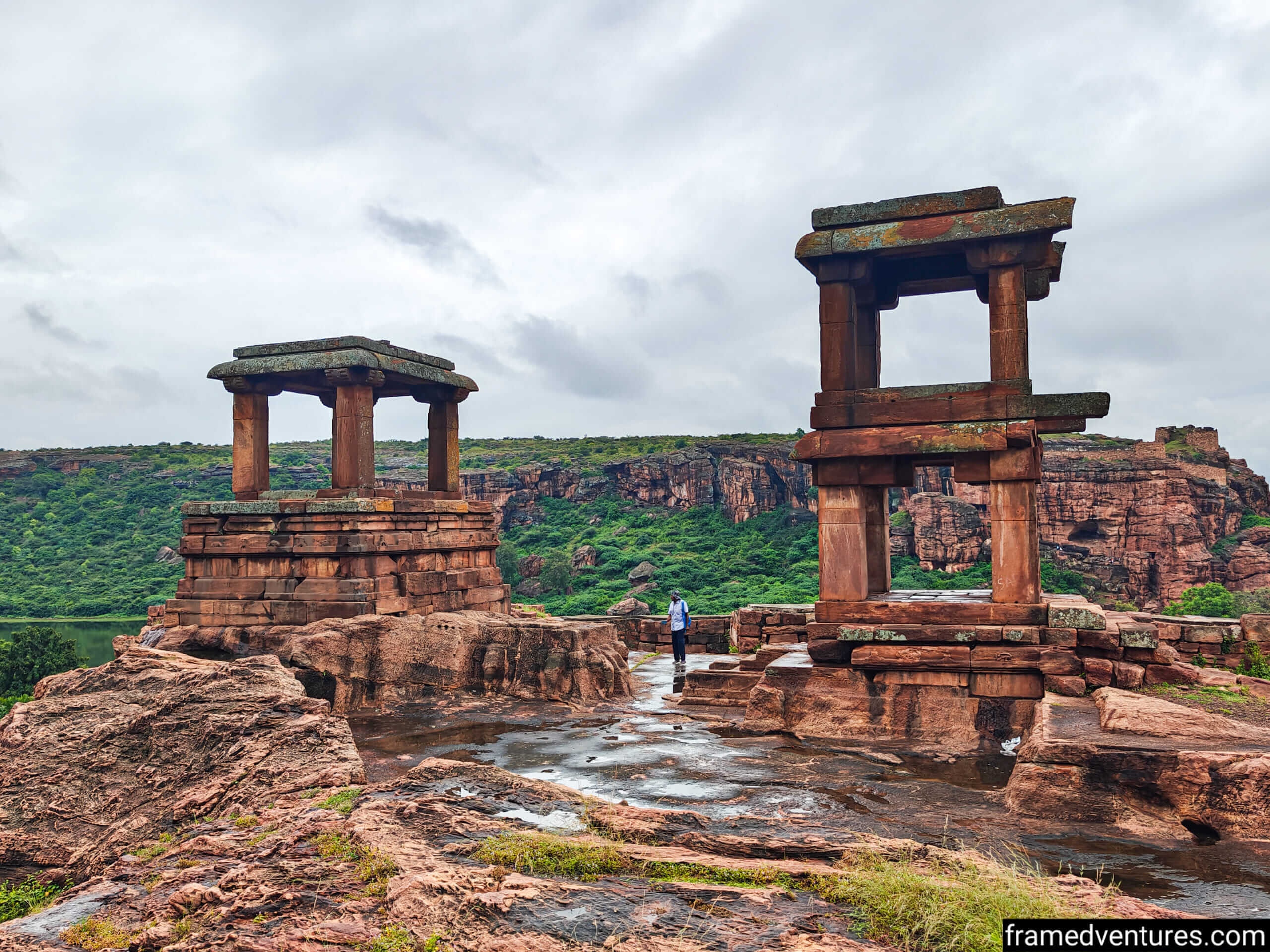
I have said it before, but it’s worth reminding you again. You should visit Badami-Aihole-Pattadakal for these two reasons:
- Architecture
- History
(Otherwise, it will be a waste of time.)
I was blown away by the architecture of the temples, which will put most of our modern infrastructure to shame.
And because I got so invested in the architecture, I ended up searching Wikipedia to learn the history behind it.
Now that I have visited Badami, I understand why Google kept recommending this place when I was doing my research on Hampi.
Frequently Asked Questions (FAQs)
1. Can we cover Badami, Aihole, and Pattadakal in one day?
Yes, it’s possible, but only if you have supersonic speed like Flash (from DC).
2. Is Pattadakal worth visiting?
For sure. It’s a UNESCO World Heritage Site, which is known for its blend of northern and southern architecture in its temples.
3. How much time is required to explore Badami?
It took me half a day to explore Badami. It depends on your speed.
4. What is the dress code in Badami?
No dress code as such. Just wear what’s comfortable for you.
5. Are Badami and Aihole the same?
Somewhat but not entirely. In Badami, you’ll find rugged sandstone hills, a lake right next to it, and a fort apart from a few temples. Meanwhile, Aihole is exclusively known for its Hindu, Buddhist, and Jain temples.






2 Comments
Aniket
Hello,
Thanks for such a excellent blog. You seem to caputre all relevant details in your brief blog. Was great help in planning my trip.
Thanks and keep up the good work.
Jerry
Thanks, Aniket! Hope you enjoyed your trip.